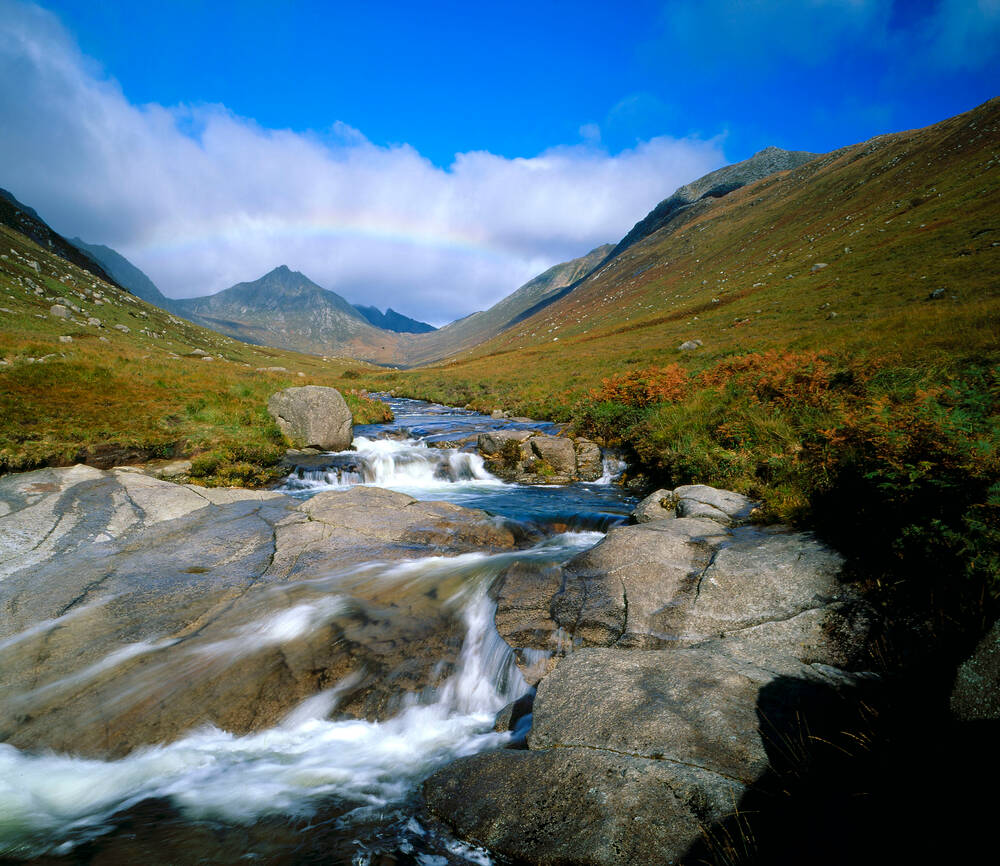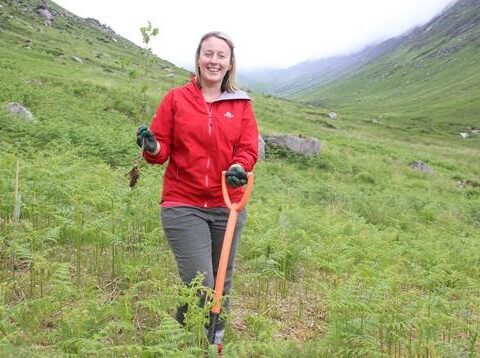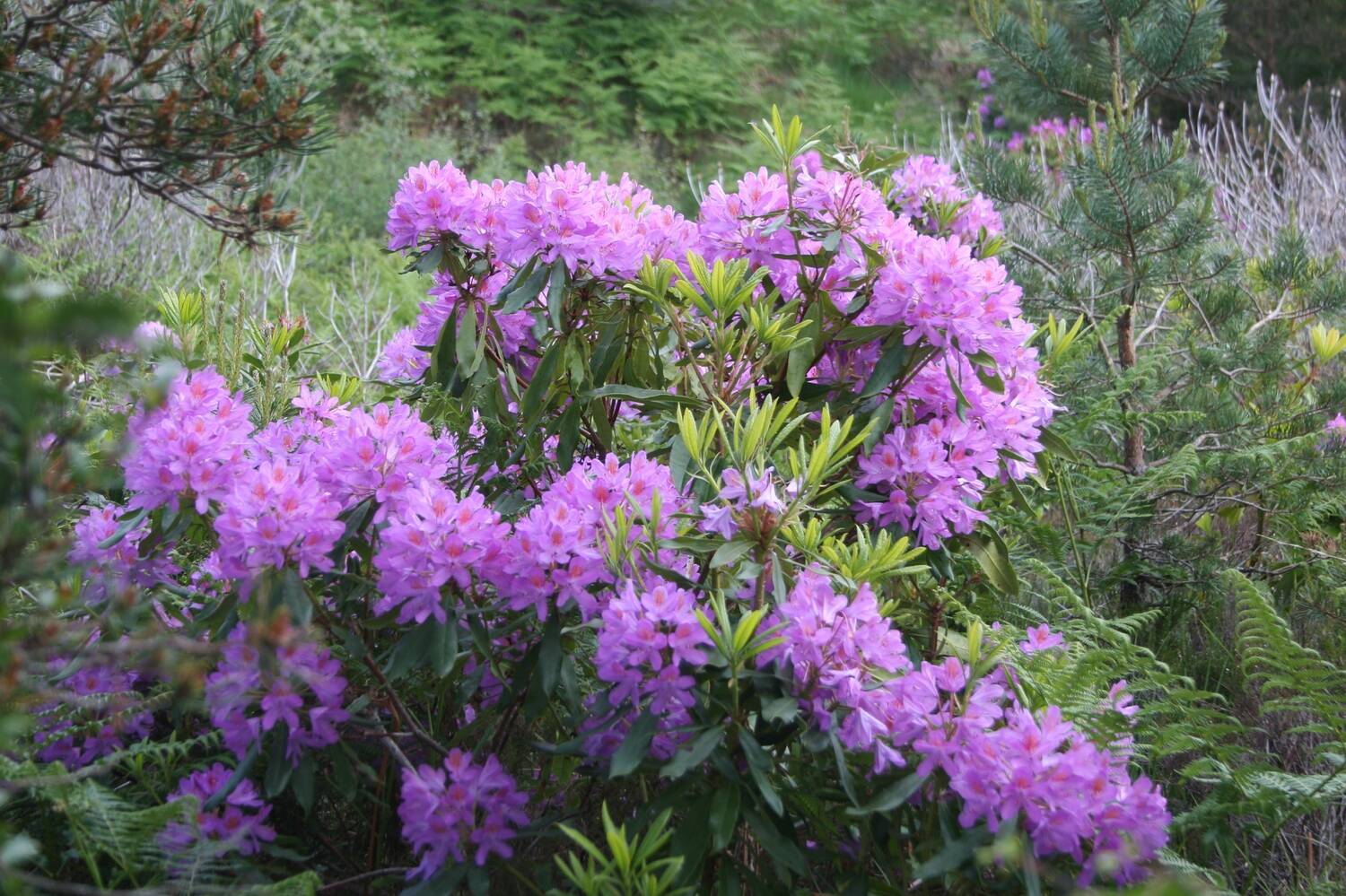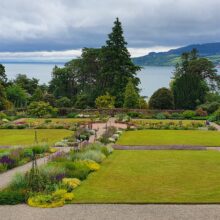Protecting and Restoring the Natural Heritage of Arran
NTS Technical Bids Manager Joanne Mould helps replant native woodland while tackling invasive spaces as she explores the natural heritage of Arran
After so many months of lockdown it was such a treat to step on to the ferry at Ardrossan bound for Arran. The day was drizzly but the CalMac café was cosy and I joined the Trust’s new Operations Manager for Arran, Stuart McKinnon, over a vegan bacon roll and a good blether.
The sea around Arran was experiencing a rare algal bloom, turning the water a tropical turquoise and as the rain cleared it was easy to mistake Brodick for Ibiza (well, maybe if you squinted!)
We were collected by our guides for the day – the Senior Ranger Kate Sampson, Ranger Corinna and Seasonal Ranger Jake – to see the progress of some of the key nature conservation projects happening on Arran.

Rainbow over Glenrosa water in Glen Rosa
First stop: Glen Rosa to see the Glen Rosa Habitat Revival project – a rewildling project that aims to bring native woodland back into the glen. Reforesting the glen is happening through a combination of natural regeneration and planting new trees. As we walked up the glen, we spotted the well-camouflaged 4km electric fence that deters deer and enables trees to grow without being grazed, plus additional exclosures constructed in the early 2000’s where trees are thriving – giving us a tantalising glimpse of what might be achieved over the next decades.

Joanne planting an Arran whitebeam tree. Credit: Kate Sampson, Senior Ranger
Glen Rosa is one of Scotland’s iconic landscapes and is protected as such via its site designation as part of the National Scenic Area.
Lots of planning and engagement has gone into the project and the team will be restoring species native to the island including birch, oak, hazel and the endemic Arran Whitebeam, a tree that occurs only on Arran.
The ranger team has also been planting new trees to supplement the natural regeneration taking place – working with contractors, volunteers, local schools and even us! Kate, Corinna and Jake put us to work planting Arran Whitebeams, making us earn our lunch break.
We then moved on to look at the team’s work on Project Wipeout, our nationwide effort to eradicate non-native species from the Trust’s places. The first phase of this work on Arran has concentrated on removing Rhododendron ponticum; despite its beauty this plant spreads to form great monocultures that prevents other plants surviving, damaging our native wildlife. It is tenacious and requires several seasons of control and ongoing monitoring to ensure it is fully eradicated.
We also looked at some of the other invasive non-native species the team will be tackling, including Sitka Spruce, a tree species used in commercial forestry which is encroaching on some of the island’s most special habitats such as heathland and peat bog. It was obvious how the sitka were marching over the hillside from the forestry plantation nearby. Salmonberry is another major problem on Arran and we saw several bushes full of ripe berries and had a sample – an acquired taste for sure!

Rhododendron ponticum is one of the key species that Project Wipeout is working to remove at sites across Scotland.
The projects have taken a lot of planning, partnership working and public engagement to deliver and it’s fantastic to see this hard work paying off with real gains for nature. In my job I spend a lot of time working with colleagues to plan projects and help our funders and donors understand the impact of their support. Getting out to see the projects in action makes them come alive and helps me to understand them and the time, effort and resource required to deliver at this scale.
The team on Arran are true experts in their fields; we are lucky to have such expertise in the Trust to protect and restore Scotland’s amazing wildlife and natural heritage. Thanks to Kate, Corinna and Jake for such a great day.
Written by Joanne Mould, the National Trust for Scotland’s Technical Bids Manager.

